Długosza and Siemiradzkiego streets in Bydgoszcz
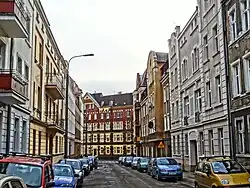 View of Siemiradzkiego street to the south | |
 Długosza street (red) and Siemiradzkiego street (blue) | |
| Native name | Ulica Henryka Siemiradzkiego, Ulica Księdza Jana Długosza w Bydgoszczy (Polish) |
|---|---|
| Former name(s) | Sophienstraße (Długosza street) / Margarethentraße (Siemiradzkiego street) |
| Part of | Okole district |
| Namesake | Jan Długosz, Henryk Siemiradzki |
| Owner | City of Bydgoszcz |
| Length | 150 m (490 ft) |
| Width | 10 metres (33 ft) |
| Location | Bydgoszcz, |
| Coordinates | 53°07′46″N 17°59′18″E / 53.12944°N 17.98833°E |
| Major junctions | Władysława Łokietka street, Śląska street |
| Construction | |
| Construction start | 1905 (Długosza street),[1] 1906 (Siemiradzkiego street)[2] |
| Completion | 1910 (Długosza street),[3] 1911 (Siemiradzkiego street)[4] |
Długosza and Siemiradzkiego streets are two short paths in the city of Bydgoszcz, Poland. Their rapid constructions within a few years in the early 1900s was translated into a uniformity of Art Nouveau facades.
Location and naming
Both streets are located in downtown Bydgoszcz, in the Okole district. They run in parallel along an approximately south to north axis, from Śląska street to Władysława Łokietka street. Długosza street is 180 metres (590 ft) long while Siemiradzkiego street 140 metres (460 ft) long.
Through history, these streets bore the following names:[5]
- Till the early 1900s, the area was called "Kanal werder" (Canal peninsula);
- From their construction till 1920, Sophienstraße (Długosza street) / Margarethentraße (Siemiradzkiego street);
- 1920–1939, Ulica Długosza and Ulica Siemiradzkiego ;
- 1939–1945, Sophienstraße (Długosza street) / Margarethentraße (Siemiradzkiego street);
- since 1945, Ulica Długosza and Ulica Siemiradzkiego .
The current namesake of these streets come from:
- Jan Długosz (1415-1480), a Polish priest, chronicler, diplomat, soldier, and secretary to Bishop Zbigniew Oleśnicki of Kraków. He is considered Poland's first historian;
- Henryk Siemiradzki (1843-1902), a Polish painter.
History
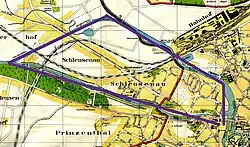
During Prussian time (1772-1920), the Okole district where both are laid was called Kanal werder (Canal peninsula). The term referred to the fact that the triangular area was almost surrounded by water ways: to the south was the Bydgoszcz Canal and to the north the Brda river. The district (renamed Schleusenau) became even an artificial island when a new branch of the Bydgoszcz canal was completed in 1915, locking up the area.[6]
The first constructions only started in 1905, at avery quick pace: a vast majority of the buildings in both streets were completed by the end of 1910.[3]
The district was preserved from both WWII destruction and soviet-time estate projects. Since the 2010s, the municipal authorities have been carrying out many renovation works in these avenues, in order to bring back their original Art Nouveau features.[7]
Main edifices
Długosza street
Tenement at 1, corner with 6 Śląska Street
1922[8]
The first landlor, Wycenty Ochocki, was a tailor living in the tenement giving onto Śląska street (then called Błonia street).[8]
This building is the only one built with modernist features, in vogue in the 1920s. It is remarkable by its numerous bay windows. Furthermore, the portal is flanked with columns and a lintel decorated with a plastered medallion displaying a child holding grapes. It has been refurbished in 2019.[7]
-
.jpg) Main facade
Main facade -
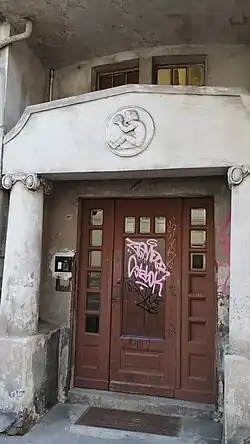 Portal and door to the street
Portal and door to the street -
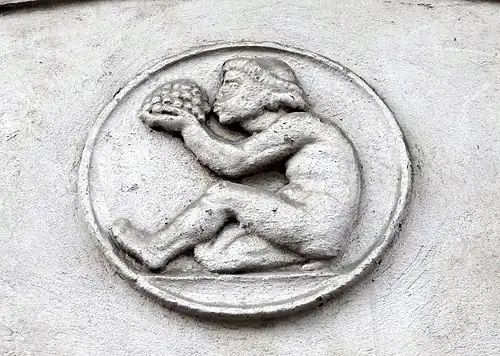 Detail of the lintel medallion
Detail of the lintel medallion
Tenement at 2, corner with 4 Śląska Street
1906[9]
The commissioner of this tenement was a banker, Martin Friedländer,[1] who did not live there. He was the directot of the Bank for trade and commerce (Bromberger bank für handel und gewerbe), located at 7 Wollmarkt (today's 12 Wool Market Square).
Recently overhauled (2022),[7] there are plentiful Art Nouveau details on both facades. In particular, each entrance door is decorated with a mascaron topped by a stylish oval transom light.
-
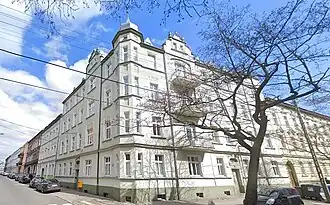 View of the corner
View of the corner -
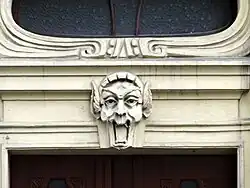 Detail of the mascaron
Detail of the mascaron -
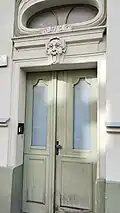 Art Nouveau door
Art Nouveau door -
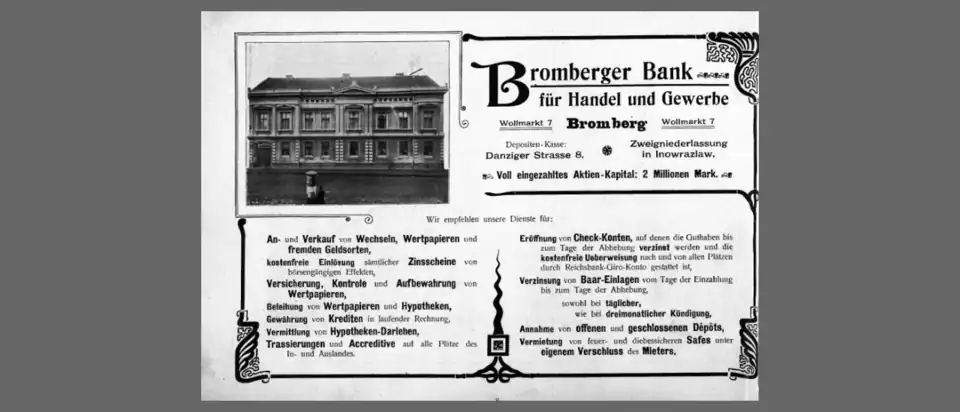 Advertising for Bromberger Bank, ca 1900
Advertising for Bromberger Bank, ca 1900
Tenement at 3
Beginning 20th century[9]
The first owner of this building (then at 12 Sophienstraße) was Anton Grabowski, a locksmith.[3]
The edifice has been refurbished in the 2010s[7] and presents a variety of Art Nouveau architectural details: vertical friezes, plastered cartouches on the facade, on window lintels and on balconies. Of note, the entrance door decoration include putti, flowers, garlands and a crossed keys symbol.
-
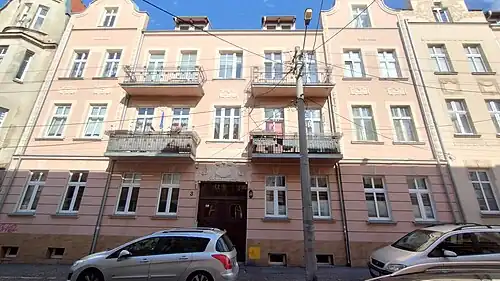 Main facade
Main facade -
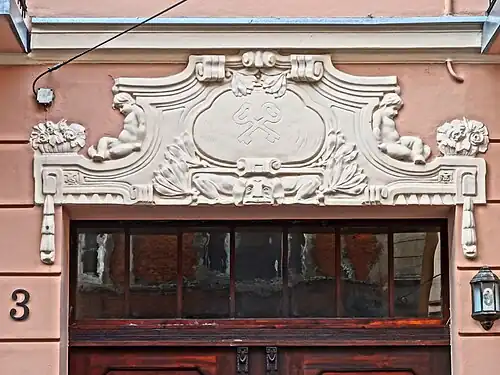 Plastered decoration
Plastered decoration -
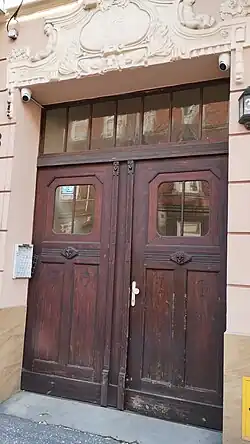 Main entrance door
Main entrance door
Tenement at 4
1905[9]
Leopold Schmidt, a carpenter, was the first landlord of this tenement at then 8 Sophienstraße. He also possessed and lived in the abutting building at No.6.[10]
This building is one of the few instances of eclectic architecture in the street.
-
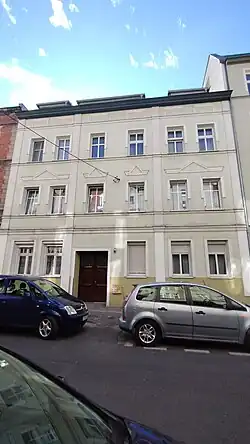 Main frontage from the street
Main frontage from the street
Tenement at 5
Beginning 20th century[9]
Bogusław Preuß, a building contractor, commissioned this building, leaving his initials BP on the plastered lintel of the entrance. He lived at 24 Albertstraße (present day Garbary Street).[3]
Renovated in 2020,[7] the decorated facade displays Art Nouveau features on its top and around the openings. The transom light above the main street entrance is lavishly decorated.
-
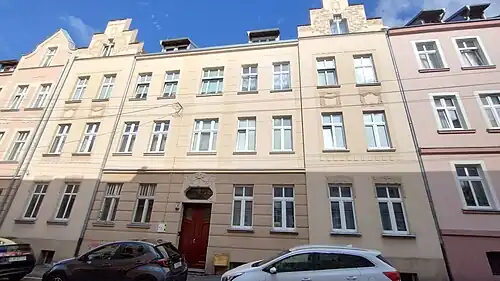 Main facade
Main facade -
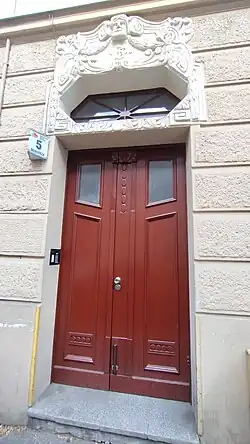 Decorated entrance door with BP initials
Decorated entrance door with BP initials -
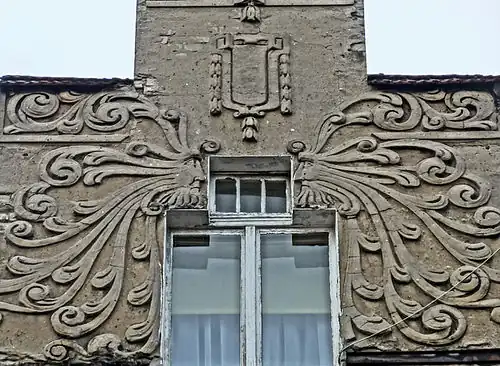 Top frontage
Top frontage
Eclectic edifices in Długosza street
| Tenement Nr. | Year of erection | First owner | Picture | Remarks |
| 6 | 1905-1907[9] | Leopold Schmidt, a carpenter. | 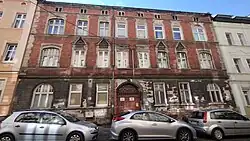 |
Leopold Schmidt also owned the building at Nr.4.[10] |
| 7 | ca 1910[9] | Eduard Burghardt, a train station supervisor.[11] | 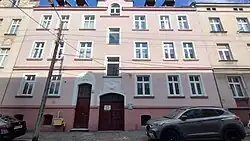 |
The renovation carried out in 2020[7] underlines the plastered decorations set above the main doors, blending vegetal and animal motifs. |
| 8 | 1906-1908[9] | Alons Kobus, an installer.[10] | 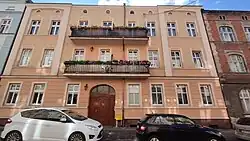 |
The building was initailly registered at 5a then 6 Sophienstraße. The tenement was renovated in 2018.[7] In particular, one can appreciate the large wooden entrance door and the two main balconies with wrought iron railings. |
| 9 | 1906-1907[9] | Gustav Winter, a private landlord.[12] | 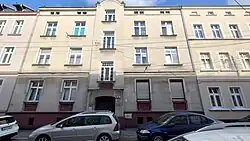 |
Very few architectural details survived on the facade. |
| 10 | 1905[9] | August Kiehl, an private landlord.[10] | 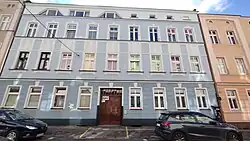 |
The tenement was renovated in 2018.[7] The wooden carvings on the entrance door are worth looking. |
| 11 | 1905-1907[9] | Franz Peterson, an entrepreneur.[10] | 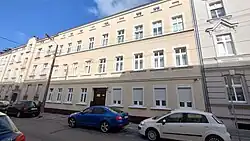 |
Julius Otto Franz was a member of the Peterson family who was influential from the beginning of the 19th century till the 1930s in the area of politics, engineering and entrepreneurship. |
| 12 | 1905[9] | Bertha König, a window, running there a guesthouse.[2] | 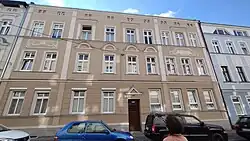 |
Remarkable plastered cartouches filled with floral motifs. |
| 13, corner with 27 Łokietka street | 1896[9] | Ignaß Borzychowski, a painter.[13] | 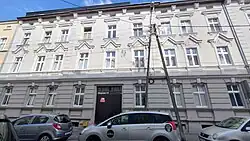 |
The edifice has been refurbished in 2018.[14] It now exhibits remarkable decorative details (e.g. plastered motifs in pediments, on top corbels and lintels). |
| 14 | 1903[9] | Adolf Körnig, a private landlord.[15] | 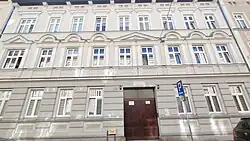 |
Initially recorded at 3 Sophienstraße. |
| 16, corner with 23/25 Łokietka street | 1897[9] | Carl Juncker, a rentier.[16] |  |
The building is being refurbished (in June 2025) by the city authorities.[17] |
Siemiradzkiego street
Main edifices in Siemiradzkiego street
| Tenement Nr. | Year of erection | First owner | Picture | Remarks |
| 10/12 Śląska Street | 1905-1910[9] | Bank Bydgoski.[4] In the mid-1910s, the bank also owned two other assets in the streets, at nr 2 and 4. | 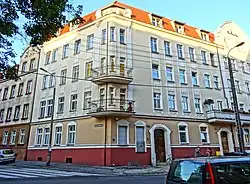 |
Renovated in 2007, both frontages exhibit late Art Nouveau details.[7] |
| 1/3, corner with 14 Śląska Street | 1910[9] | Josef Raniecki, a saddler.[11] |  |
The building presents a narrow corner, but large frontages with early modernist features on both streets. It underwent a renovation in 2021.[7] |
| 2 | 1907-1910[9] | Josef Raniecki, a saddler.[11] | 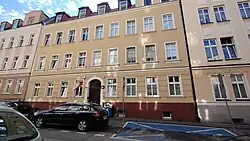 |
The entrance door presents a nice fanlight. The edifice was refurbished in 2014. |
| 4 | 1907-1910[9] | Josef Raniecki, a saddler.[11] | 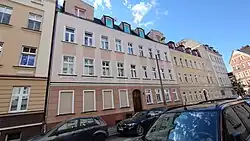 |
Eclectic architecture, mirroring the neighbouring edifice at nr.2 |
| 5 | 1904-1905[9] | Josef Grabowski, a painter.[2] | 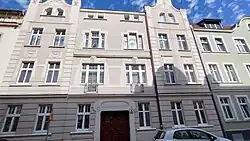 |
The facade boasts many Art Nouveau elements, especially in pediments and around the door portal. |
| 6 | 1907[9] | Josef Raniecki, a saddler.[11] | 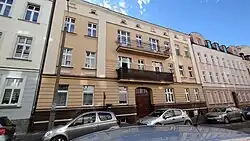 |
One can highlight the large adorned wooden door and the two balconies with a wrought iron railing. |
| 7 | 1906[9] | Gustav Winter, a private landlord.[2] | 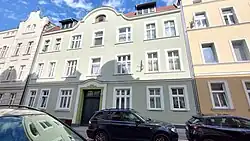 |
Building restored in 2021. |
| 8 | 1908[9] | Gustav Rodewald, a carpenter.[12] | 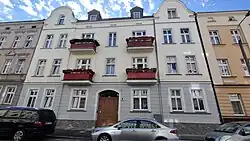 |
One of the largest frontages in the street |
| 9 | 1904-1906[9] | Paul Gehrke, a train driver.[12] |  |
Building restored in 2021. |
| 10 | 1905-1906[9] | Gustav Rodewald, a carpenter.[12] | 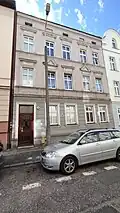 |
|
| 11, corner with 31 Łokietka street | 1897-1899[9] | Carl Baumgart, a glazier.[18] | 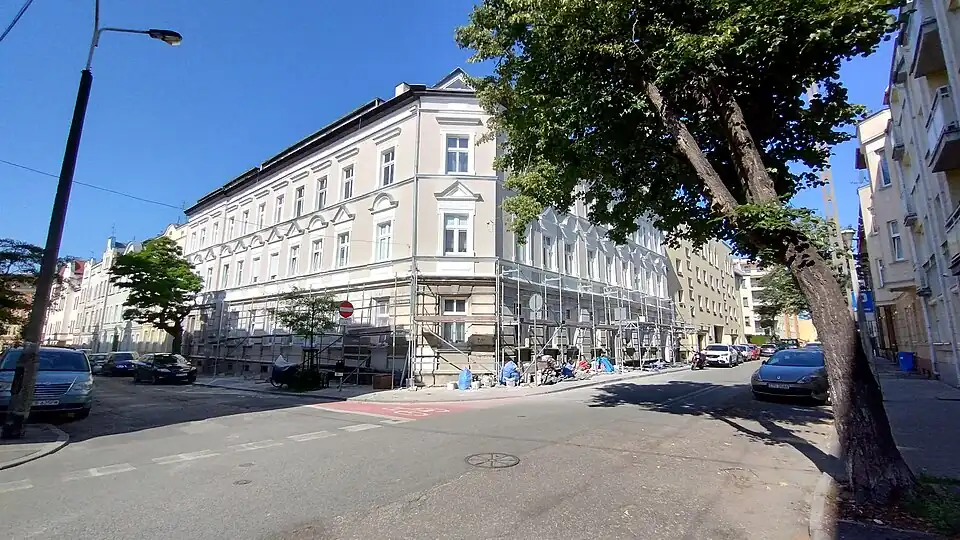 |
The tenement is being refurbished (in June 2025).[19] The facades of the wings stretching along both streets are decorated with pediments and cornices, while the ground floor is highlighted with bossage. Both individual entrances on the streets display adorned portals.[20] |
| 12, corner with 29 Łokietka street | 1897-1898[9] | Ignaß Borzychowski, a saddler.[18] | 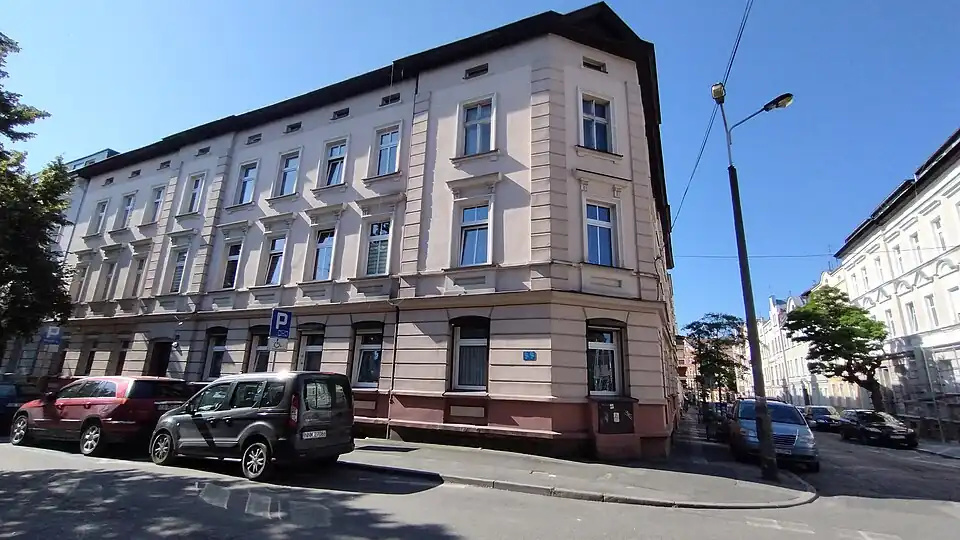 |
A restoration had been carried out in 2007.[7] |
See also
- Bydgoszcz
- Bydgoszcz Canal
- Władysława Łokietka street
- Peterson family, Bydgoszcz
- Art Nouveau
- Eclecticism in architecture
- Modern architecture
References
- ^ a b Gardiewski, C. (1905). Adressbuch nebst allgemeinem Geschäfts-Anzeiger von Bromberg und dessen Vororten auf das Jahr 1905 : auf Grund amtlicher und privater Unterlagen [Address book and general business gazette of Bromberg and its suburbs for the year 1905 : based on official and private documents] (in German). Bromberg: A. Dittmann. pp. 51, 97, 98.
- ^ a b c d Gardiewski, C. (1906). Adressbuch nebst allgemeinem Geschäfts-Anzeiger von Bromberg und dessen Vororten auf das Jahr 1906 : auf Grund amtlicher und privater Unterlagen [Address book and general business gazette of Bromberg and its suburbs for the year 1906 : based on official and private documents] (in German). Bromberg: A. Dittmann. pp. 61, 66, 98, 226.
- ^ a b c d Gardiewski, C. (1910). Adressbuch nebst allgemeinem Geschäfts-Anzeiger von Bromberg und dessen Vororten für 1910 : auf Grund amtlicher und privater Unterlagen [Address book and general business gazette for Bromberg and its suburbs for 1910: based on official and private documents] (in German). Bromberg: A. Dittmann. pp. 161, 296, 412.
- ^ a b Gardiewski, C. (1911). Adressbuch nebst allgemeinem Geschäfts-Anzeiger von Bromberg und dessen Vororten für 1911: auf Grund amtlicher und privater Unterlagen [Address book and general business gazette for Bromberg and its suburbs for 1911: based on official and private documents] (in German). Bromberg: A. Dittmann. p. 176.
- ^ Czachorowski, Antoni (1997). Atlas historyczny miast polskich, Tom II Kujawy, Zeszyt I Bydgoszcz [Historical atlas of Polish cities, Volume II Kujawy, Issue I Bydgoszcz.] (in Polish). Toruń: Uniwersytet Mikołaja Kopernika. p. 13. ISBN 83-231-0891-9.
- ^ Weckwerth, Piotr (14 June 2021). "Bydgoskie osiedla BEZ FILTRÓW – OKOLE" [Bydgoszcz housing estates WITHOUT FILTERS – OKOLE]. turystykabezfiltrow.com (in Polish). Bydgoszcz: Adbis. Retrieved 19 June 2025.
- ^ a b c d e f g h i j k "Mapa inwestycji" [Investment map]. bydgoszczwbudowie.pl (in Polish). Bydgoszcz: Reimus. 14 June 2021. Retrieved 19 June 2025.
- ^ a b Gardiewski, C. (1922). Adresy Miasta Bydgoszczy na rok 1922 [Address of the city of Bydgoszcz for the year 1922] (in Polish). Bydgoszcz: Władysław Weber. pp. 104, 106.
- ^ a b c d e f g h i j k l m n o p q r s t u v w x y z Zarzadzenie NR 439/2015 Prezydenta Miasta Bydgoszczy [Order No. 439/2015 of the Mayor of Bydgoszcz] (in Polish). Bydgoszcz: Miasto Bydgoszczy. 7 August 2015. pp. 12, 13, 39, 41, 43, 65, 74, 75.
- ^ a b c d e Gardiewski, C. (1907). Adressbuch nebst allgemeinem Geschäfts-Anzeiger von Bromberg und dessen Vororten für 1907: auf Grund amtlicher und privater Unterlagen [Address book and general business gazette for Bromberg and its suburbs for 1907: based on official and private documents] (in German). Bromberg: A. Dittmann. pp. 147, 302, 358, 391.
- ^ a b c d e Gardiewski, C. (1909). Adressbuch nebst allgemeinem Geschäfts-Anzeiger von Bromberg und dessen Vororten für 1909: auf Grund amtlicher und privater Unterlagen [Address book and general business gazette for Bromberg and its suburbs for 1909: based on official and private documents] (in German). Bromberg: A. Dittmann. pp. 251, 408.
- ^ a b c d Gardiewski, C. (1908). Adressbuch nebst allgemeinem Geschäfts-Anzeiger von Bromberg und dessen Vororten für 1908: auf Grund amtlicher und privater Unterlagen [Address book and general business gazette for Bromberg and its suburbs for 1908: based on official and private documents] (in German). Bromberg: A. Dittmann. pp. 157, 283, 481.
- ^ Gardiewski, C. (1897). Wohnungs-Anzeiger nebst Adress- und Geschäfts-Handbuch für Bromberg und Umgebung : auf das Jahr 1897 [Housing directory and address and business directory for Bromberg and surrounding area: dating back to 1897] (in German). Bromberg: Dittmann. pp. 21, 49, 150, 160. Retrieved 23 June 2025.
- ^ "Okole nam ładnieje. Kolejna kamienica po remoncie" [Our neighborhood is looking nicer. Another tenement house has been renovated.]. bydgoszcz.wyborcza.pl (in Polish). Bydgoszcz: Wyborcza Sp zoo. 18 July 2018. Retrieved 8 August 2025.
- ^ Gardiewski, C. (1904). Adressbuch nebst allgemeinem Geschäfts-Anzeiger von Bromberg und dessen Vororten auf das Jahr 1904: auf Grund amtlicher und privater Unterlagen [Address book and general business gazette of Bromberg and its suburbs for the year 1904: based on official and private documents] (in German). Bromberg: A. Dittmann. p. 96.
- ^ Gardiewski, C. (1898). Wohnungs-Anzeiger nebst Adress- und Geschäfts-Handbuch für Bromberg und Umgebung : auf das Jahr 1898 [Housing directory and address and business directory for Bromberg and surrounding area: dating back to 1898] (in German). Bromberg: Dittmann. p. 82. Retrieved 24 June 2025.
- ^ UAF (7 February 2025). "Odnowią fasady, zlikwidują „kopciuchy"" [They will renovate the facades and eliminate the "smokestacks"]. bydgoszcz.pl (in Polish). Bydgoszcz: Miasto Bydgoszcz. Retrieved 24 June 2025.
- ^ a b Gardiewski, C. (1899). Wohnungs-Anzeiger nebst Adress- und Geschäfts-Handbuch für Bromberg und Umgebung : auf das Jahr 1899 [Housing directory and address and business directory for Bromberg and surrounding area: dating back to 1899] (in German). Bromberg: Dittmann. pp. 11, 82. Retrieved 24 June 2025.
- ^ redakcja (2 January 2025). "Remont narożnej kamienicy przy ulicach W. Łokietka i H. Siemiradzkiego" [Renovation of the corner tenement house at W. Łokietka and H. Siemiradzkiego streets]. strefabydgoszcz.com.pl (in Polish). Bydgoszcz: strefabydgoszcz. Retrieved 25 June 2025.
- ^ em (2 January 2025). "Pięknieją elewacje kamienic na bydgoskim Okolu. Ulice stają się wizytówką dzielnicy i miasta" [The facades of tenement houses in Bydgoszcz's Okole district are becoming more beautiful. The streets are becoming the district's and city's showcase.]. expressbydgoski.pl (in Polish). Bydgoszcz: Polska Press Sp. z o.o. Retrieved 25 June 2025.
Bibliography
- Umiński, Janusz (1996). Bydgoszcz. Przewodnik [Bydgoszcz. Guide] (in Polish). Bydgoszcz: Regionalny Oddział PTTK "Szlak Brdy".
